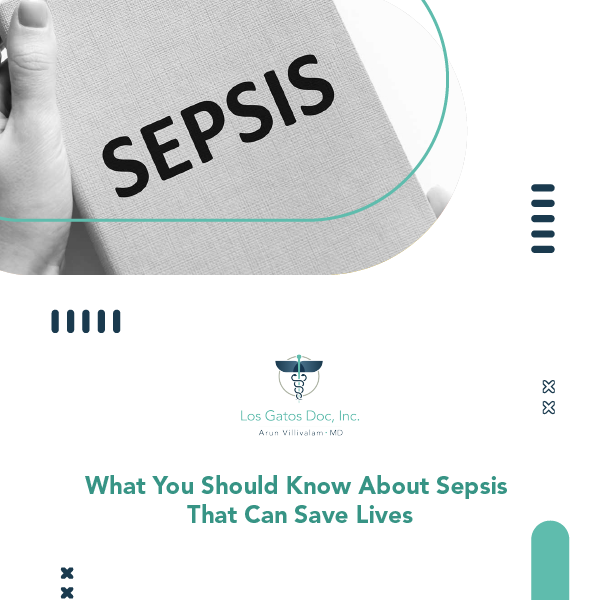The body’s severe response to an infection is sepsis. Sepsis is a life-threatening condition that, if left untreated, can cause organ failure, tissue damage, and even death. Over 1.7 million Americans contract sepsis annually, and at least 270,000 of them succumb to death according to the Centers for Disease Control and Prevention (CDC).
Since sepsis usually develops from an illness that starts outside the hospital, public awareness and education is essential to saving lives.
What Is Sepsis?
Sepsis is a rare, serious complication of an infection.
Bacterial infections are the most common cause of sepsis. While the source of the bacterial infection can be anywhere in your body, the common infection sites are the lungs, stomach, urinary tract, and bloodstream.
While It is usually bacterial infections, viral infections, such as influenza or COVID-19 and fungal infections, can also lead to sepsis.
Noninfectious insults, such as injury, can also lead to sepsis as they trigger your body’s immune responses like infections.
Sepsis can cause multiple organ failure and death if it’s not treated quickly. Sepsis commonly affects infants or older adults.
What Causes Sepsis?
Our immune system usually limits infection to one place by producing white blood cells. This is called a localized infection. The white blood cells travel to the infected site and release proteins, cytokines, and other mediators to destroy the germs causing the infection. It helps fight the infection and prevent it from spreading.
But, if our immune system is compromised, or the illness is severe, it may spread to other body parts. Extensive inflammation has the potential to harm the tissue and disrupt blood flow. The obstruction of blood flow can make the blood pressure go dangerously low. The organs and tissues do not receive oxygen and nutrients, eventually leading to organ failure.
What Are The Three Stages Of Sepsis?
There are three stages of sepsis:
- Sepsis: Sepsis is when your immune system overreacts to an infection and attacks your organs and tissues. It is easy to cure sepsis in this stage with antibiotics and fluids (either orally or through IV) treatment.
- Severe sepsis: When your immune system attacks your organs and they don’t receive enough blood, it can cause severe sepsis characterized by organ malfunction. The heart is one of the first affected organs in severe sepsis with the infection of the bloodstream.
- Septic shock: Septic shock is the extreme case and is marked by organ failure as the blood pressure remains dangerously low despite treatment with fluids. Once a patient reaches the final stage, i.e. septic shock, the mortality rates increase to 30-40%.
What Are The Signs And Symptoms Of Sepsis?
Early sepsis detection and prompt treatment can mean the difference between life and death. The first step is to stop the infections that cause sepsis. Sepsis can manifest as a combination of any of the following signs and symptoms:
- Extreme pain or discomfort
- Disorientation or confusion
- Shortness of breath
- Rapid heartbeat
- Fever
- Sweaty skin
Septic shock is a serious condition that can turn fatal with organ failure. While septic shock can be frightening, immediate treatment is crucial and could save your life. Know the warning signs of septic shock so you know when to call 911, or your doctor or get to the emergency room right away.
- Loss of consciousness
- Severe breathlessness
- Low body temperature or a high temperature (fever)
- Dangerously low blood pressure
- Shift in mental state, such as bewilderment or dizziness
- Slurred speech
- A rapid heartbeat
- Fast breathing rate
- Cold, clammy, pale, or mottled skin
- Chills and shivers
- Muscular ache
- Faintness or dizziness
- Nausea and vomiting
- Diarrhea
Visit your primary care doctor frequently for follow-up check-ups if you’ve suffered from septic shock to aid in your rehabilitation.
How To Prevent Sepsis
According to the World Health Organization (WHO), there are two steps to preventing sepsis:
- Prevention of microbial transmission and infection, which involves hygiene practices such as hand washing, sanitization, safe preparation of food, water sanitization, vaccination, and having good nutrition to improve immunity.
- Prevention of an infection developing into sepsis includes early detection of sepsis, immediate medical care, and antibiotic treatment.
If You Believe You Have Sepsis, Act Fast
Sepsis can be fatal if left unchecked and untreated. Get all infections treated in time to prevent them from progressing to sepsis. If your infection doesn’t seem to improve or appears to be getting worse, you need immediate medical attention.
If you delay treatment, a simple infection could lead to a deadly condition like sepsis, which can result in serious complications such as organ failure, and even death.
(Disclaimer: We routinely draw upon public health resources to inform our write-ups. Information in this article may be drawn up from multiple public health sources, including:
- Centers for Disease Control & Prevention
- Medline Plus
- National Institutes of Health
- American Medical Association
- American Association of Family Physicians
- Mayo Clinic
- Family Doctor






